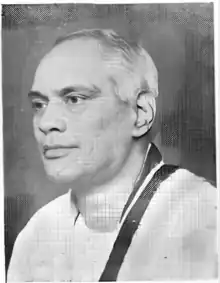Kala Venkata Rao | |
|---|---|
 | |
| Minister of Revenue, Government of Andhra Pradesh | |
| In office 17 April 1957 – 28 March 1959 | |
| Preceded by | Position established |
| Succeeded by | Konda Venkata Ranga Reddy |
| Minister of Revenue, Madras Presidency | |
| In office 23 March 1947 – 24 January 1949 | |
| Preceded by | K. Koti Reddi |
| Succeeded by | H. Sitarama Reddi |
| Member of the Andhra Pradesh Legislative Assembly for Kothapeta | |
| In office 23 April 1955 – 28 March 1959 | |
| Preceded by | Newly created |
| Succeeded by | M.V.S.S. Raju |
| Member of the Madras Legislative Assembly for Amalapuram (General) | |
| In office 1937–1952 | |
| Succeeded by | Nadimpalli Ramabhadra Raju |
| Personal details | |
| Born | 7 July 1900 Mukkamala, East Godavari District, British India |
| Died | 28 March 1959 Hyderabad, Andhra Pradesh, India |
| Political party | Indian National Congress |
| Spouse | Rajeswaramma |
| Children | None |
| Occupation | Freedom fighter, Politician |
| Signature |  |
Kala Venkata Rao was an Indian independence activist and politician. He served as the Minister for Revenue in the governments of the Madras Presidency and Andhra Pradesh. He also served as the Minister of Finance in the latter.
A member of the Indian National Congress, Rao served as vice-president and general secretary of the Andhra Pradesh Congress Committee (APCC) between 1939 and 1946. He also served as general secretary of the All India Congress Committee (AICC) between 1949 and 1951. Recognizing his role in the independence movement, Neelam Sanjiva Reddy called him the "Dronacharya" of the Andhra movement struggle. He was also referred as Andhra Patel.[1]
Birth
Rao was born in Mukkamala, East Godavari District of Andhra Pradesh on 7 July 1900[2] to Kala Brahmayya and Kala Venkamma. His parents were originally from Nadipudi village, West Godavari District of Andhra Pradesh. Mukkamala was his maternal grandmother's village. He had a younger sister and he was three years elder than her.
Education
Rao had his primary education at his native place Mukkamala and secondary education at Middle School, Pulletikurru and Board High School, Amalapuram. He joined intermediate class in Maharajah's College, Vizianagaram. He passed Intermediate and joined B.A. in the same college during the academic year 1919–20. But he was sent out of college as he happened to be ring-leader of anti-British feelings in the college. Thereupon he joined senior B.A. class at Noble College, Machilipatnam. Those were the days of non-cooperation movement. When Mahatma Gandhi gave a call for boycott of the law courts, educational institutions and legislative bodies, Kala Venkata Rao who was bubbling with patriotic enthusiasm responded to this call; gave up his studies and jumped into the fray.
Marriage
Rao married Rajeswaramma, the daughter of Duvvuri Venkateswarulu, then the village munsiff of Mukkamala, on 20 April 1914. His father-in-law was a great patriot, philanthropist and gentleman. He is related to Sripada Krishnamurty Sastry, the first poet laureate of Andhra Pradesh and Bouloussou Soubramanion Sastroulou, politician from French Yanam through their wives and Sripada Venkata Ratnamba (née Kala) and Bouloussou Souryapracassamma (née Kala), respectively.
Politics
Rao was a freedom fighter and joined the Indian National Congress. He was elected as M.L.A. from Amalapuram assembly constituency (general) located in East Godavari district of Madras presidency in 1937 Legislative election[3] and 1946 Legislative election. He held cabinet ministries during tenures of Omandur Ramaswamy Reddiar and Kumaraswamy Raja. He was also a member of Indian Constituent Assembly elected from Madras Presidency.[4] He was member of 7-member Partition Committee which was set up on 7 December 1949 by then Madras Government for the formation of Andhra State out of Madras State.[5] The committee was set up under the Chairmanship of Kumaraswamy Raja, the then Chief Minister of Madras Presidency, wherein Andhra was represented by other members along with him such as Tanguturi Prakasam, Bezawada Gopala Reddy and Neelam Sanjiva Reddy. However, he was runner-up from Amalapuram constituency in 1952 election, where he lost to Nadimpalli Ramabhadra Raju of KMPP.[6] He was also member of AICC.[7] Later, Andhra state formed in 1953 and Amalapuram constituency became single seat reserved one. He then got as M.L.A. elected from nearby Kothapeta constituency in 1955 election.[8]
Death
Rao died on 28 March 1959 in Hyderabad from cardiac arrest while he was recovering from influenza. The Speaker of the Lok Sabha, M. A. Ayyangar, while paying homage to Rao called him "one of the stalwart statesmen of Andhra Pradesh".[9]
Offices held
See also
References
- ↑ Nellore Sri Rama Murthy (ed.). "ఆంధ్ర పటేలు శ్రీ కళా వెంకట్రావు అస్తమయం" (PDF) (in Telugu). Zameen Ryot. Retrieved 14 August 2022.
- ↑ "Archived copy" (PDF). Archived from the original (PDF) on 21 July 2011. Retrieved 14 September 2010.
{{cite web}}: CS1 maint: archived copy as title (link) - ↑ p. 289, The Who's who in Madras, Issue 9, Pearl Press, 1937.
- ↑ "Constituent Assembly Members". www.constitutionofindia.net. Retrieved 13 August 2022.
- ↑ T., Vasundhara (1992). "VI The Andhra Claim for Madras City" (PDF). The Final Phase Of The Andhra Movement 1947 56 A Critical Study (Doctoral thesis). Sri Venkateswara University. p. 261. Retrieved 3 July 2022.
- ↑ "Statistical Report on General Election, 1951 : To the Legislative Assembly of Madras" (PDF). Election Commission of India. Archived from the original (PDF) on 27 January 2013. Retrieved 13 August 2022.
- ↑ Congress hand-book, 1946, By Indian National Congress
- ↑ "STATISTICAL REPORT ON GENERAL ELECTION, 1955 TO THE LEGISLATIVE ASSEMBLY OF ANDHRA PRADESH" (PDF). Election Commission of India. Retrieved 13 August 2022.
- ↑ "Kala Venkata Rao Passes Away". The Indian Express. 29 March 1959. p. 1.
- ↑ Justice Party golden jubilee souvenir, 1968 - Google Boeken. 5 June 2010. Retrieved 4 August 2013.